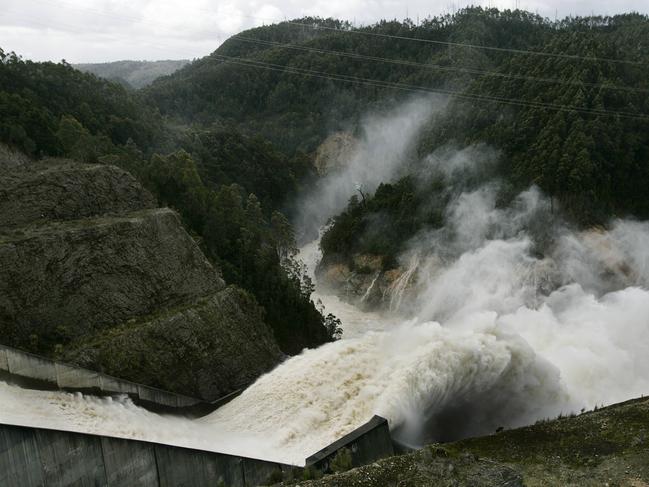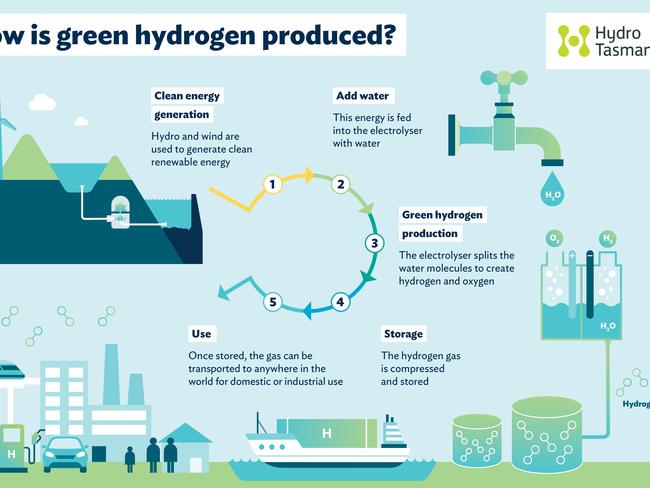Talking Point: Just add water — Tasmania in the box seat for hydrogen revolution
STEVE DAVY: Tasmania’s hydro power gives it the advantage in emissions-free production of fuel

Opinion
Don't miss out on the headlines from Opinion. Followed categories will be added to My News.
In the debate over the best way to transition to a low-carbon economy, much has been written about renewable energy sources like hydropower, solar and wind.
But increasingly the focus has turned to hydrogen’s potential to contribute enormously to the new energy production landscape.
For most people, hydrogen is best known as the two atoms that combine with one atom of oxygen to make water.
With its ability to power everything from our homes to transport and industry, scientists believe it has exciting possibilities as a global energy source. It’s also an energy carrier, meaning it can be generated by renewable energy, stored then delivered as needed. Hydrogen is a very common colourless and odourless chemical. It is the most abundant chemical element in the universe, and makes up the bulk of stars like the sun.
But while hydrogen is all around us, on Earth it occurs only in compound form with other elements, in liquids, gases or solids. As well as water, this includes fossil fuels like coal and petroleum.

So producing hydrogen means it has to be separated from the substance. To make clean energy hydrogen, or “green” hydrogen, a process known as electrolysis splits water into hydrogen and oxygen, using an electric current. If the electricity is sourced from renewable energy like hydropower, wind or solar, the process is completely emissions-free.
Once the hydrogen has been produced, it can be used as fuel locally or turned into ammonia or synthetic natural gas (SNG) for transport.
Ammonia and SNG can be transported then reconverted to hydrogen and used as zero-emissions fuel.
It’s clear that when created from renewable energy, hydrogen has enormous benefits for the environment. Imagine a transport industry, where cars, trucks, boats and planes are powered by hydrogen used in fuel cells – emitting only water, not carbon dioxide.
And, with Korea looking to green hydrogen as a way to meet emission reduction targets, hydrogen has massive potential to be a lucrative export market for Australia.
With such advantages and the technology to make it happen, why hasn’t hydrogen fulfilled its long-understood promise as a clean-energy solution?
The answer is simply economics – compared with other fuels, green hydrogen is expensive to produce.
But with an expected reduction in the cost of electrolysers and the renewable energy needed to power them, the future is looking up for hydrogen – and that’s where Tasmania comes in.
Our analysis shows Tasmania is in a unique position to lead the nation in production of green hydrogen, with the potential to develop a large-scale, cost-competitive green hydrogen industry over the coming decade.
The analysis indicates that green hydrogen can be produced in the state for about 10 to 15 per cent less than other Australia power grids needing to offset emissions and 20 to 30 per cent less than from dedicated off-grid renewables.
Tasmania’s advantage comes from its hydro generation system, which is capable of firming up supply from renewable energy resources so supply is maintained even in the event of low wind or solar generation. This leads to a much higher use of hydrogen production plant than would be the case from low-emission renewable energy generation – and that’s just more efficient.
This competitive edge extends to reliability of supply, a strong electricity grid and projected self-sufficiency in renewable energy by 2022, strong transport infrastructure options and more options for supply through further interconnection and the Battery of the Nation initiative.
We also have the water supply needed for large-scale production. For example, a 100 megawatt plant, capable of powering 90,000 cars for 15,000km a year would require 50 to 100 Olympic swimming pools of water.
This equates to less than 5 per cent of a combined cycle gas turbine power station.
Hydrogen production would create additional Tasmanian industry, along with skilled job opportunities, bringing substantial benefits for the state’s economy.
It’s an emerging industry, and turning it into the energy revolution some have predicted is not without its challenges. But with a National Hydrogen Strategy in sight, the blocks needed to build it may be settling into place. With that, an exciting opportunity will be there to be seized. And Tasmania is in the box seat.
Steve Davy is chief executive of Hydro Tasmania.


